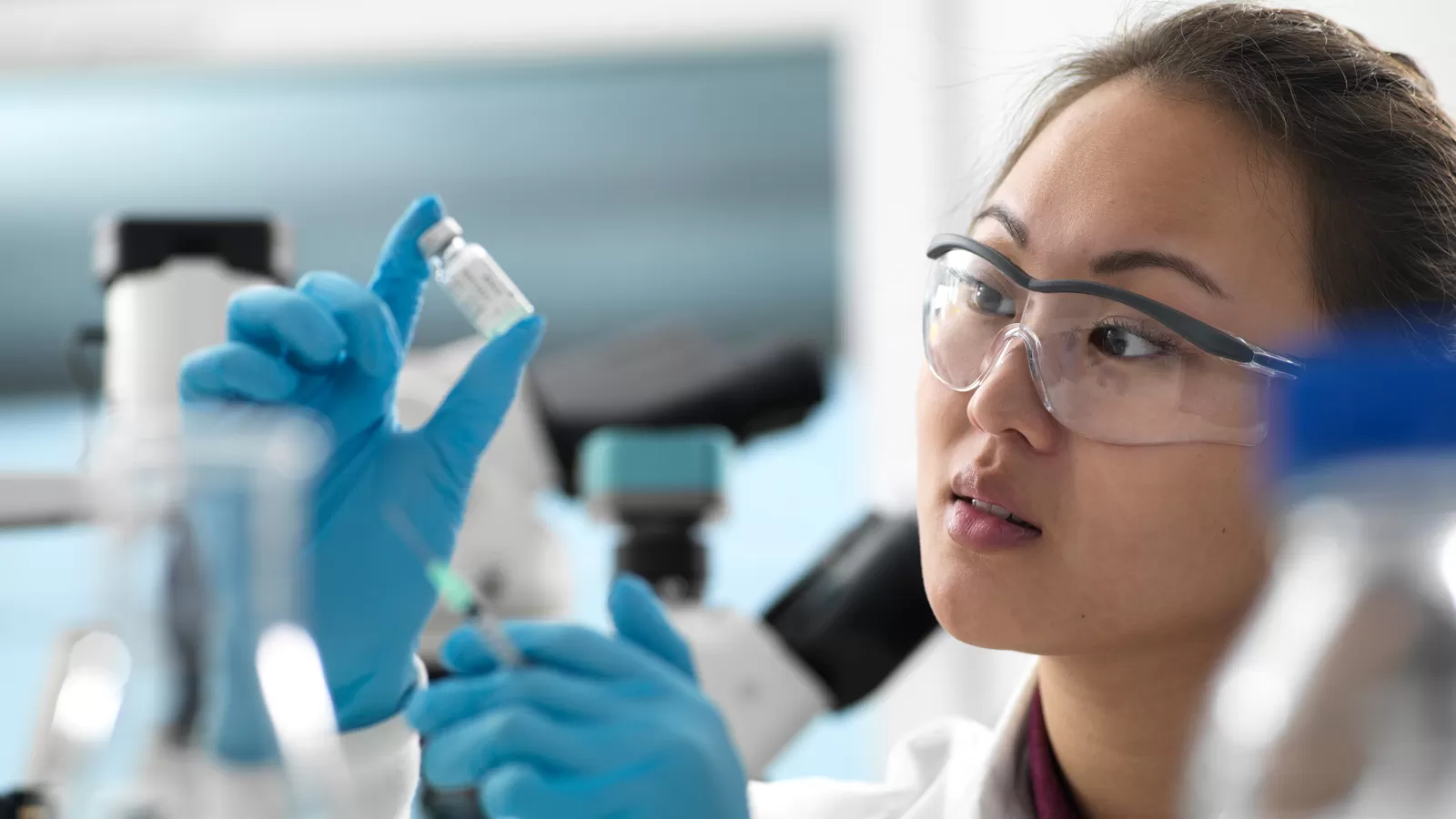The Next Frontier of Vaccine Innovation

Edward Jenner changed the world when he used cowpox virus to inoculate a young boy against smallpox.1 Less than 200 years later, smallpox was eradicated from the Earth.2 Dozens of vaccines have since been created, leading to dramatic improvements in public health as well as a marked decline in deaths due to diseases such as measles, pertussis (whooping cough), and tetanus.
Imagine what Jenner would say if he knew that at least two vaccines now help prevent cancers!3 Or that the world’s scientists developed multiple highly effective COVID-19 vaccines approximately one year after clinicians first reported cases of a then-unknown viral illness?
Vaccine innovations have paved the way toward improved human health and will continue to do so.
“So much has been achieved, yet we are only scratching the surface of the potential vaccines hold,” says Nanette Cocero, PhD, Global President of Pfizer Vaccines.
Here are three areas to watch as we enter the next frontier of vaccine innovation:
mRNA Technology
In 2021, the Pfizer and BioNTech COVID-19 vaccine became the first mRNA product to achieve full approval from the U.S. Food and Drug Administration. Traditionally, vaccines have been made using the whole or part of a bacteria or virus, but mRNA technology has taken vaccine development to the next level. mRNA vaccines contain messenger RNA (that’s what mRNA stands for), which is essentially a genetic blueprint that tells the body how to produce a protein that will trigger the immune system to generate the precise antibodies and immune cells needed to destroy a particular bacteria or virus.
Scientists have been exploring the potential of mRNA for a long time. That’s one reason COVID-19 vaccines were developed so quickly. Another reason: mRNA molecules are easier to produce in the laboratory than the proteins or viral fragments used in other types of vaccines, which means that mRNA vaccines can be manufactured more rapidly.4 This ease of production can also make it easier to change mRNA vaccines if a new viral strain emerges.
Expect more mRNA vaccines in the future. Pfizer has already launched Phase 1 clinical trials of mRNA influenza vaccines.5 Pfizer and BioNTech are also working to co-develop the first-ever mRNA-based vaccine for shingles, a disease that currently infects one in three Americans during their lifetimes, according to the CDC, and causes significant pain, suffering, and even death.6
“A shingles vaccine with improved tolerability and scalability could make a significant impact globally,” Cocero says.
Maternal Vaccination
Pregnant individuals are at higher risk of vaccine-preventable disease than non-pregnant individuals. Very young infants are also especially susceptible to infectious diseases because their immune systems are immature.
Because pregnant people naturally share antibodies with fetuses via the placenta during pregnancy, vaccinating individuals during pregnancy has “emerged as a promising tool to tackle infant morbidity and mortality worldwide,” according to a 2020 article published in Frontiers in Microbiology.7
Since 2012, the CDC and American College of Obstetricians and Gynecologists (ACOG) have recommended that pregnant individuals receive a Tdap (tetanus, diphtheria, and pertussis vaccination) during the third trimester so that infants are born with protection against pertussis in their first months of life when they are extremely vulnerable to serious whooping cough disease.8
Widespread maternal vaccination for pertussis can decrease infant deaths, as nearly 70% of all pertussis deaths in the U.S. currently occur in babies who are too young for childhood vaccination.9
Another disease that disproportionately affects young infants is respiratory syncytial virus (RSV). As is the case with many infectious diseases, RSV can cause serious respiratory infection in infants and older adults. Infants under six months of age are at especially high risk due to their immature immune systems and their small airways. One to two out of every 100 children younger than 6 months of age with RSV may need to be hospitalized for difficulty breathing.10
Pfizer is pioneering the development of a maternal vaccine to prevent RSV infection in infants, as well as a vaccine to prevent group B streptococcal (GBS) infection in newborns.
“Group B step is an infectious disease that has been associated with preterm births and stillbirths, and can cause meningitis, pneumonia, and bloodstream infections in babies,” says Yasmeen Agosti, MD, Vice President, Global Maternal Immunization Franchise Medical Lead at Pfizer.
Healthcare providers currently screen pregnant people for group B strep and administer antibiotics during labor if GBS is detected, but some babies still go on to develop this invasive disease. In addition, screening and intrapartum antibiotics as a prevention strategy has not been able to prevent late-onset group-B step disease in infants.
“Maternal vaccination has the potential to fight RSV, Group B strep, and other common infant infectious diseases, including herpes simplex and cytomegalovirus,” Cocero says. “We look forward to more research and development in this space.”
Vaccine Delivery
Ensuring equitable access to vaccines can improve global well-being. Vaccine manufacturers, clinicians, politicians, business leaders, and engineers are working together to create and fund innovative vaccine delivery systems that will get vaccines to the people who need them.
“There are still many people around the world who don’t have access to medicines and vaccines, and these ‘last mile’ communities face poorer health outcomes as a result,” Cocero says. “Innovation is crucial to closing this gap, and groundbreaking technology has offered a glimpse of what can be achieved.”
In 2021, drones successfully delivered mRNA COVID-19 vaccines—vaccines that must be kept ultra-cold during transport – to rural Ghana.11 Watch for additional technological innovations that will assure timely delivery of essential vaccines to vulnerable locales.
1. A Brief History of Vaccination. The Immunisation Advisory Centre. Accessed April 18. 2022. https://www.immune.org.nz/vaccines/vaccine-development/brief-history-vaccination.
2. History of Smallpox. U.S. Centers for Disease Control and Prevention. Accessed April 18. 2022. https://www.cdc.gov/smallpox/history/history.html
3. Vaccines (Shots). U.S. Centers for Disease Control and Prevention. Accessed April 18. 2022. https://www.cdc.gov/cancer/dcpc/prevention/vaccination.htm
4. How Does a mRNA Vaccine Compare to a Traditional Vaccine? Vanderbilt University Medical Center. Updated November 16, 2020. Accessed April 18. 2022. https://www.vumc.org/viiii/infographics/how-does-mrna-vaccine-compare-traditional-vaccine
5. Abbasi, J. Pfizer Launches Phase 1 mRNA Flu Vaccine Trial. JAMA. 2021; 326(18), 1784. doi: 10.1001/jama.2021.19634. Accessed April 18, 2022.
6. Shingles (Herpes Zoster). U.S. Centers for Disease Control and Prevention. Accessed April 18. 2022. https://www.cdc.gov/shingles/hcp/clinical-overview.html
7. Saso, A, & Kampmann, B. Maternal Immunization: Nature Meets Nurture. Frontiers In Microbiology, 11. 2020; doi: 10.3389/fmicb.2020.01499. Accessed April 18, 2022.
8. Kerr S, Van Bennekom CM, Liang JL, Mitchell AA. Tdap Vaccination Coverage During Pregnancy — Selected Sites, United States, 2006–2015. MMWR Morb Mortal Wkly Rep 2017;66:1105–1108. DOI: http://dx.doi.org/10.15585/mmwr.mm6641a3External. Accessed April 18, 2022.
9. Vaccine (Shot) for Whooping Cough (Pertussis). U.S. Centers for Disease Control and Prevention. Accessed April 18. 2022. https://www.cdc.gov/vaccines/parents/diseases/pertussis.html
10. RSV in Infants and Young Children. U.S. Centers for Disease Control and Prevention. Accessed April 18. 2022. https://www.cdc.gov/rsv/high-risk/infants-young-children.html
11. Pfizer. Zipline, Pfizer and BioNTech Collaboration Paves the Way for Automated, On-Demand Delivery of First mRNA COVID-19 Vaccines in Ghana [press release]. November 11, 2021. Accessed April 18, 2022. https://www.pfizer.com/news/press-release/press-release-detail/zipline-pfizer-and-biontech-collaboration-paves-way
![]()





